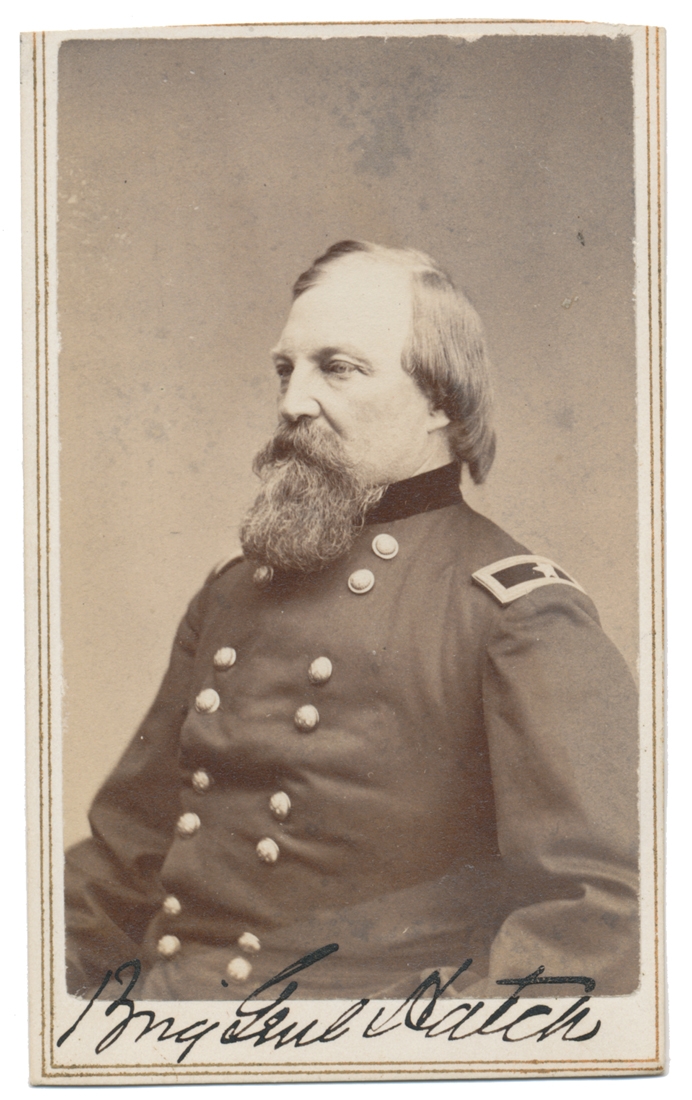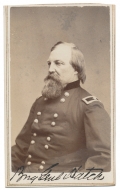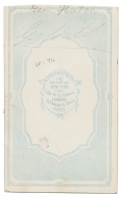site search
online catalog
WARTIME VIEW OF MEDAL OF HONOR RECEIPIENT BRIGADIER GENERAL JOHN HATCH

$135.00 SOLD
Quantity Available: None
Item Code: 1094-168
Images of General Hatch are not common. This is a nice CDV showing the General in left profile from the waist up. He wears a dark double-breasted frock coat with a black felt collar and brigadier general’s shoulder straps.
Image has excellent contrast and clarity. Paper and mount are also very nice. Bottom of the mount has a bold period ink ID of “BRIG. GEN. HATCH.”
Reverse has photographer’s imprint for C. D. FREDRICKS & CO…NEW YORK. There is a period pencil inscription with a modern pencil ID above it.
John Porter Hatch was born in Oswego, N. Y. on January 9, 1822. He graduated from the United States Military Academy in 1845, ranking 17th in his class. He experienced his first active field service as a second lieutenant in the 3rd U.S. Infantry during the Mexican War. In May 1846, he served under General Zachary Taylor at Palo Alto and Resaca de la Palma. He was later transferred to serve under Winfield Scott in the Mounted Rifles and was brevetted as a first lieutenant for gallant service in the subsequent battles of Contreras and Churubusco, and captain for bravery at Chapultepec. When the war ended, Hatch was assigned to various posts on the frontier of the Old West, as well as in Oregon. He married Adelaide Goldsmith Burckle in 1851; the couple raised two children. In the next decade, Hatch participated in several expeditions against Indians. He was promoted to the full rank of captain in October 1860 and served as the Chief of Commissary for the army's Department of New Mexico.
Following the outbreak of the Civil War, Hatch was ordered to the East and assigned to the cavalry of George B. McClellan. He was made a brigadier general of volunteers on September 28, 1861. In December, he was assigned command of a brigade of cavalry stationed at Annapolis, Maryland, serving under General Rufus King. Hatch's brigade made a series of daring raids on enemy positions near the Rapidan and Rappahannock rivers. These raids gained his brigade the Nickname Iron Brigade, which followed that brigade up until January 1863, long after Hatch had moved on.
In March 1862, Hatch assumed command of the cavalry of Major General Nathaniel P. Banks Corps. He served in the Valley Campaign and fought at the First Battle of Winchester. In August of that year, after incurring the wrath of army commander John Pope for two failed cavalry raids, he was reassigned to the infantry. He commanded a brigade in the I Corps, assuming division command after Brig. Gen Rufus King fell ill with epilepsy the evening before Second Bull Run. Hatch led the division there and at the Battle of South Mountain, where he was shot in the leg. He was brevetted as a major general of volunteers and subsequently received the Medal of Honor for his gallantry under severe enemy fire.
Hatch was disabled until February 1863, when he returned to light administrative duties, serving as a judge on courts-martial and commanding the draft rendezvous at Philadelphia in July. He then commanded the cavalry depot at St. Louis during the late summer and early autumn. On October 27, 1863, he was promoted to the Regular Army rank of major of the 4th U.S. Cavalry.
In 1864, he was assigned to the Department of the South, where he had charge of the coast division. He was in charge of operations on John's Island, South Carolina, in July and led the Federal forces at the Battle of Honey Hill in November. He subsequently operated in cooperation with Major General William T. Sherman in the Georgia-Carolinas Campaign and took part in the attack on Charleston. Following the city's surrender, Hatch assumed military command of it from February to August 1865.
In the promotions following the war, he was brevetted from March 1865 both as a major general of volunteers and as a colonel in the Regular Army.
Hatch stayed in the regular Army following the war, reverting to his regular rank of major. For the next twenty-six years, he again served on the frontier. He was promoted to lieutenant colonel in 1873. Eight years later, he became colonel of the 2nd U.S. Cavalry. In 1881, while still a lieutenant colonel, Hatch was reassigned from Fort Elliott at Mobeetie in Wheeler County, much to the dismay of area residents. On July 4 of that year, the Wheeler County Commissioners Court authorized a resolution honoring Hatch for his service at Fort Elliott: "He has proven himself at all times agreeable to the citizens of this section and willing to aid them as a community or as individuals whenever such aid has been required, and to the fullest extent of his power."
Hatch served at Fort Concho in San Angelo, Texas, Indian Territory, Montana Territory, and finally in Washington Territory.
He retired on January 9, 1886, and moved to New York City. He received the Medal of Honor in 1893 in recognition for his service at South Mountain. Hatch was President of the Aztec Club of 1847 of New York and a member of the Oswego County Historical Society.
John P. Hatch died in New York City in the spring of 1901. He was buried with full military honors in Arlington National Cemetery. [ad]
~~~~~~~~~~~~~~~~~~~~~~~~~~~~~~~~~
THIS ITEM, AS WITH ALL OTHER ITEMS AVAILABLE ON OUR WEB SITE,
MAY BE PURCHASED THROUGH OUR LAYAWAY PROGRAM.
FOR OUR POLICIES AND TERMS,
CLICK ON ‘CONTACT US’ AT THE TOP OF ANY PAGE ON THE SITE,
THEN ON ‘LAYAWAY POLICY’.
THANK YOU!
Inquire About WARTIME VIEW OF MEDAL OF HONOR RECEIPIENT BRIGADIER GENERAL JOHN HATCH
For inquiries, please email us at [email protected]
Most Popular
Historical Firearms Stolen From The National Civil War Museum In Harrisburg, Pa »
Theft From Gravesite Of Gen. John Reynolds »
Cavalry Carbine Sling Swivel »
Fine Condition Brass Infantry Bugle Insignia »
featured item
U.S. 1834 OFFICER’S SWORD OF MAJOR R.M. KIRBY U.S. ARMY WITH 6th PLATE AMBROTYPE BY REES OF SON JOSEPH L.S. KIRBY AS C.S. ARMY 2nd LIEUTENANT WITH THIS VERY SWORD, PART OF AN EXTENSIVE FAMILY ARCHIVE
This substantial archive descended in the family of Joseph Lee Smith Kirby (4 Nov. 1841- 28 July 1933,) who left West Point to join the Confederate Army in 1861 and was among the last to surrender in June 1865 at Galveston, TX. The extended family… (870-310). Learn More »




